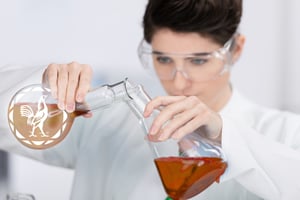
The importance of a controlled fermentation of tequila musts in the production of this drink is well established and recognized, however, the role that musts play in the process is seldom recognized. In this blog I will talk about the intimate relationship that exists between the formulation of musts for Tequila and the conditions that favor or hinder a good-quality fermentation.
MUST PREPARATION (Formulation)
The syrups obtained from the extraction and hydrolysis of the agave pineapples are collected in tanks and transported by pipes to the formulation tubes. In this syrups we can find some sugars such as glucose, sucrose but mainly, fructose. It is at this stage that we decide to which product category will the syrup be destined: 100% Tequila or Tequila.
To obtain a 100% Tequila, the formula is made only with agave juice and water while if you want to get Tequila, the formula is made with agave juice, water and also other sugars. Such sugars may be: standard sugar, corn syrup, piloncillo, glucose, molasses, etc. It is important to mention that, according to the Tequila Regulatory Council (CRT), a minimum of 51% of sugars derived from Tequilana Weber Agave Blue Variety, must be added in order to produce tequila, and the rest may be any of the before mentioned sugars.
WHAT IS ALCOHOLIC FERMENTATION?
Fermentation is an anaerobic biological process in which simple sugars, such as glucose and fructose, are turned into to ethanol and carbon dioxide by the action of yeasts (responsible for the fermentation process). These yeasts are microorganisms that, when they are in a sugar-enriched medium, they reproduce and generate large amounts of alcohol and CO2.
CONDITIONS FOR QUALITY FERMENTATION
To have a good-quality fermentation, it is important to control several conditions within which the following stand out:
- ANAEROBIOSIS: Have good anaerobic conditions (no aeration in fermentation tanks).
- BALANCED NUTRIENTS: Enough substrate for the yeast.
- CONTAMINATION CONTROL: Avoid contamination by other microorganisms that may produce undesirable substances. This is a key issue in the fermentation process of the tequila that uses open tubes, because some powder might fall on the fermented broth and it could contain contaminating organisms. In order to ensure the quality of our products we, at Casa Sauza, have completely closed tanks, which are ventilated with vents so the CO2 can find an exit. In addition, there is a CIP (Clean in place) cleaning system, ensures a perfect internal sanitization and thus, avoid contamination of environmental air bacteria and yeasts, known as wild yeasts.
- TEMPERATURE CONTROL: During the process, we monitor the optimum conditions of temperature and time needed to obtain the greatest amount of ethanol. In Casa Sauza, we have a jacket cooling system or packing. It is through this system that we can keep the temperature controlled between 34-37 ° C which helps us avoid to stress the yeast by high temperatures. It also helps us to reduce losses caused by alcohol evaporation.
- PH CONTROL: It is important to control the pH levels (4-6) that favor yeast in the must formulation so we provide an optimal environment for them during the Fermentation process.
- CHANGE OF METABOLISM: The passage from aerobic to anaerobic metabolism is crucial. During the preparation of the yeast stage, prior to fermentation, the yeast is usually subjected to an aeration system in order to raise its cells population. Special care must be taken in order to remove the air in the fermentation step.
- CONCENTRATION OF SUGARS: There may be problems during the fermentation process when the concentration of sugars in the must is either insufficient or excessive.
- CONCENTRATION OF ALCOHOL: If there is a high concentration of alcohol, the yeasts can stress and die.
- SINGLE YEAST: Always use the same yeast strains suitable for production. It is known that in more than a 50% of the factories, the fermentation process is carried out while the wild yeasts are present in the agave juice. In some others, yeasts are also used for baking, wine making or they are separated from the must itself. In Casa Sauza, all of our products come from fermentation carried out by a single strain of yeast (Saccharomyces cerevisiae), which is isolated from the habitat of our Fermentation rooms.
MUST FERMENTATION
Once the must mixes with all the rest of ingredients, the fermentation begins. At this stage, alcohol, carbon dioxide and energy are produced in the form of heat, as well as other components that provide the characteristic organoleptic properties of a tequila. The must in fermentation is effervescent.
The fermentation time varies according to the environment's temperature, and this in turn, changes with each season of the year. This fermentation process can last between 24 to 30 hours, depending on the initial sugar content of the must. This process is similar to the development curve of any other microorganism, having at first an exponential growth, then a second linear phase and then a final decreasing state.
At the moment that the effervescence stops, the process ends and it is common to say that the must is dead; either the yeasts have finished the conversion of sugar into alcohol or they did in fact die because, even though they had sugar, the medium probably became too toxic for their survival.
After the fermentation stage, the must is left to give rise to the generation of important aromatic compounds in the product. Once this stage is completed, the must is ready to be distilled.
This process has evolved during time thanks to our Total Productive Maintenance Program. Casa Sauza cares for constant improvement in order to always produce the best-quality tequila.
Learn more about our tequila production processes on the links below. You can also come and visit Casa Sauza and see how we produce our high-quality tequilas for yourself!
.png?width=50&height=50&name=10.CS-Redondo%20(1).png)
